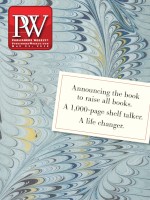U.S.-Soviet tensions frame Krugler’s Rip the Angels from Heaven (Pegasus Crime, July), set during WWII in Washington, D.C., and Los Alamos, N.Mex.
What don’t Americans understand about the race to build the A-bomb?
All of the contingencies and unknowns concerning the project during the summer of 1945. The success of the test and the deployment of bombs by July–August 1945 were not guaranteed. What if the test fizzled? What if the Japanese submarine attack that sunk the USS Indianapolis (the cruiser that delivered the atomic bombs to the Pacific) on its return trip had, instead, hit the Indianapolis while it was en route? More than 100,000 lives in Hiroshima and Nagasaki would have been spared, but if Japan fought on, how many Allied lives and Japanese lives would have been lost in the campaigns to force Japan’s unconditional surrender?
Did Americans in the 1940s have an accurate view of the Soviet threat?
Americans got a decidedly mixed message then. On the one hand, the Soviets were our allies, and wartime propaganda and Hollywood films promoted a picture of the Soviets as loyal, hard-fighting allies committed to the destruction of Nazism. On the other hand, Americans understood that communism was a threat. They hoped that the U.S. and the U.S.S.R. could continue to cooperate after the war, and President Franklin Roosevelt encouraged this optimistic view even as signs emerged that Stalin and the Soviets were going to deal with Eastern Europe, especially Poland, in ways that the U.S. opposed.
You’re a history professor who’s studied this era in depth. Would you say the stakes for the U.S. with respect to Russia’s ambitions are lower or higher now?
I think the end of the Cold War has lulled us into a false sense of security, especially when it comes to nuclear weapons. More nations now have nuclear weapons than did during the Cold War. Also, while the threat of all-out war with Russia has lessened, U.S.-Russian relations are now at a Cold War level of tension. The stakes concerning Russian intentions in Europe, Syria, Ukraine, and U.S. domestic politics, just to cite a few examples, are high indeed.
What aspect of Los Alamos were you trying to highlight given the numerous other thrillers set there?
In working out the story, I thought the most original approach for me was to bring in a late arrival (my narrator, Lt. Ellis Voigt), give him a very specific mission to accomplish at Los Alamos, and drop him down there just before the test of the first atomic weapon in the desert on July 16, 1945. This way, readers could, through Voigt’s eyes, marvel at the strangeness; the secrecy; and the palpable, complex mood of excitement, foreboding, and uncertainty that was in the air in Los Alamos at that time.



 Volume 265
Issue 21
05/21/2018
Volume 265
Issue 21
05/21/2018





